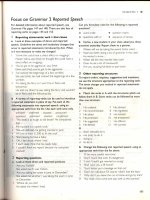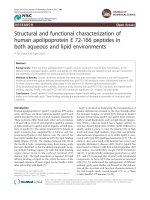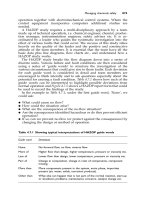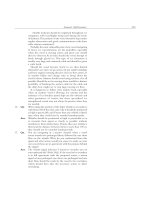Astm e 1519 16
Bạn đang xem bản rút gọn của tài liệu. Xem và tải ngay bản đầy đủ của tài liệu tại đây (69.48 KB, 3 trang )
Designation: E1519 − 16
Standard Terminology Relating to
Agricultural Tank Mix Adjuvants1
This standard is issued under the fixed designation E1519; the number immediately following the designation indicates the year of
original adoption or, in the case of revision, the year of last revision. A number in parentheses indicates the year of last reapproval. A
superscript epsilon (´) indicates an editorial change since the last revision or reapproval.
1. Scope
alkalinity agent, n—a material that can be added to the spray
mixture to raise the pH.
1.1 This terminology is used or is likely to be used in test
methods, specifications, guides, and practices related to agricultural tank mix adjuvants.
amphoteric surfactant, n—a surface-active agent capable of
forming, in aqueous solution, either surface-active anions or
surface-active cations depending on the pH.
1.2 These definitions are written to ensure that standards
related to agricultural tank mix adjuvants are properly understood and interpreted.
anionic surfactant, n—surface-active agent in which the
hydrophilic portion of the molecule forms exclusively a
negative ion (anion) when placed in aqueous solution.
2. Referenced Documents
2.1 ASTM Standards:2
D459 Terminology Relating to Soaps and Other Detergents
D483 Test Method for Unsulfonated Residue of Petroleum
Plant Spray Oils
E609 Terminology Relating to Pesticides
D2140 Practice for Calculating Carbon-Type Composition
of Insulating Oils of Petroleum Origin
antifoaming agent, n—a material used to inhibit or prevent the
formation of foam.
attractant, n—a material that attracts specific pests.
basic blend, n—a combination of wetting agent and buffering
agent that maintains a pH of the spray mixture greater than
7.
buffer or buffering agent, n—a compound or mixture that,
when contained in solution, causes the solution to resist
change in pH. Each buffer has a characteristic limited range
of pH over which it is effective.
3. Terminology
3.1 Terms and Definitions:
absorption, n—a process in which one material (the absorbent)
takes in and retains another (the absorbate).
canopy penetrating agent, n—an adjuvant that increases the
penetration of the spray material into the crop canopy. See
deposition aid.
acidifier, n—a material that can be added to spray mixtures to
lower the pH.
activator, n—a material that increases the biological efficacy of
agrichemicals.
cationic surfactant, n—a surface-active agent in which the
hydrophilic portion of the molecule forms exclusively a
positive ion (cation) when placed in aqueous solution.
active ingredient, n—a component of the formulation that
produces a specific effect for which the formulation is
designed.
colorant, n—a material used to alter the color of the tank mix.
compatibility agent, n—a surface-active agent that allows
simultaneous application of liquid fertilizer and
agrichemical, or two or more agrichemical formulations, as
a uniform tank mix, or improves the homogeneity of the
mixture and the uniformity of the application.
adjuvant, n—a material added to a tank mix to aid or modify
the action of an agrichemical, or the physical characteristics
of the mixture.
1
This terminology is under the jurisdiction of ASTM Committee E35 on
Pesticides, Antimicrobials, and Alternative Control Agents and is the direct
responsibility of Subcommittee E35.22 on Pesticide Formulations and Delivery
Systems.
Current edition approved Sept. 15, 2016. Published September 2016. Originally
approved in 1993. Last previous edition approved in 2015 as E1519 – 15b. DOI:
10.1520/E1519-16.
2
For referenced ASTM standards, visit the ASTM website, www.astm.org, or
contact ASTM Customer Service at For Annual Book of ASTM
Standards volume information, refer to the standard’s Document Summary page on
the ASTM website.
crop oil concentrate, n—an emulsifiable petroleum oil-based
product containing 15 to 20 % w ⁄w surfactant and a minimum of 80 % w/w phytobland oil.
crop oil (emulsifiable), n—an emulsifiable petroleum oilbased product containing up to 5 % w ⁄w surfactant and the
remainder of a phytobland oil.
crop oil (non-emulsifiable), n—See phytobland oil.
Copyright © ASTM International, 100 Barr Harbor Drive, PO Box C700, West Conshohocken, PA 19428-2959. United States
1
E1519 − 16
defoaming agent, n—a material that eliminates or suppresses
foam in the spray tank
naphtha-based oil, n—a petroleum oil containing a majority
of the naphtha fraction.
deposition aid, n—a material that improves the ability of
agrichemical sprays to deposit on targeted surfaces.
nonionic surfactant, n—a surface-active agent that has no
ionizable functional groups.
dormant oil, n—a horticultural spray oil applied during the
dormant phase of the targeted plant. (See horticultural
spray oil.)
drift control agent, n—See drift reduction agent.
oil, n—See petroleum, vegetable, paraffinic, and so forth.
paraffinic oil, n—a petroleum oil (derived from paraffin crude
oil) whose paraffinic carbon type content is typically greater
D2140
than 60 %.
drift reduction agent, n—a material used in liquid spray
mixtures to reduce driftable fines.
penetrant, n—a material that enhances the ability of an
agrichemical to enter a substrate or penetrate a surface.
drift retardant, n—See drift reduction agent.
petroleum oil, n—oil derived from petroleum; contains a
mixture of hydrocarbons that are broadly classified as
paraffins, napthenes, aromatics, or other unsaturates, or
combination thereof.
driftable fines, n—the percent volume of spray droplet size
distribution that is under 105 microns.
emulsifier, n—a surfactant that promotes the dispersion of one
immiscible liquid in another.
phytobland oil, n—a highly refined paraffinic material with a
D483
minimum unsulfonated residue of 92 % v/v.
esterified seed oil, n—a modified seed oil wherein the fatty
acids are esterified with an alcohol (such as methyl or ethyl).
rainfastness agent,
rainfastness.
evaporation reduction agent, n—a material that reduces the
evaporation rate of a spray mix during or after application, or
both.
n—a
material
which
improves
E609
silicone surfactant, n—a surface active agent in which at least
75 % (by weight) is derived from organically modified
silicone.
extender, n—a material that increases the effective life of an
agrichemical after application.
soil retention agent, n—a substance that increases the time an
agrichemical or water remains in the targeted soil zone.
foam suppressant, n—See defoamer.
foaming agent, n—a material that increases the volume or
stability of the foam formed in a spray mixture.
spreader, n—a material which increases the area that a droplet
of a given volume of spray mixture will cover on a target.
foliar retention agent, n—a substance that increases the time
and agrichemical remains in the targeted foliar zone.
spreader/sticker, n—a material that has the properties of both
a spreader and a sticker.
functioning agent, n—a component of the formulation that
produces a specific effect for which the formulation is
designed.
sticker, n—a material that assists the spray deposit to adhere to
the target in terms of resistance to wind, water, mechanical
action.
high surfactant oil concentrate, n—an emulsifiable oil based
product containing 25-50% w/w surfactant and a minimum
of 50% w/w oil.
high surfactant crop oil concentrate, n—a high surfactant oil
concentrate where the oil is a petroleum oil.
high surfactant modified vegetable oil concentrate, n—a
high surfactant oil concentrate where the oil is a modified
vegetable oil.
high surfactant vegetable oil concentrate, n—a high surfactant oil concentrate where the oil is a vegetable oil.
surface-active agent, n—a material comprised of lipophilic
and hydrophilic parts that when added to a liquid medium
modifies the properties of the surface or interface by
concentrating at the surface or interface.
DISCUSSION—Surface-active agent is the general term which includes soluble detergents in liquid medium, dispersing agents, emulsifying agents, foaming agents, penetrating agents, and wetting agents.
D459
surfactant, n—See surface-active agent.
vegetable oil, n—oil extracted from seeds; typically those of
corn, cotton, peanut, rapeseed, sunflower, canola, or soybean.
humectant, n—a material which increases the equilibrium
water content and increases the drying time of an aqueous
spray deposit.
modified vegetable oil, n—an oil, extracted from seeds, that
has been chemically modified (for example, methylated).
vegetable oil concentrate, n—an emulsifiable vegetable oil
product containing 5 to 20 % w ⁄w surfactant and a minimum
of 80 % w/w vegetable oil.
modified vegetable oil concentrate, n—an emulsifiable,
chemically modified vegetable oil product containing 5 to
20 % w/w surfactant and the remainder chemically modified
vegetable oil.
water conditioning agent, n—a material that reduces or
eliminates the antagonism between a pesticide and ions
present in the application water and results in improved
bioefficacy.
2
E1519 − 16
wetting agent, n—wetting agents can be considered synonymous with spreaders in function.
This standard is subject to revision at any time by the responsible technical committee and must be reviewed every five years and
if not revised, either reapproved or withdrawn. Your comments are invited either for revision of this standard or for additional standards
and should be addressed to ASTM International Headquarters. Your comments will receive careful consideration at a meeting of the
responsible technical committee, which you may attend. If you feel that your comments have not received a fair hearing you should
make your views known to the ASTM Committee on Standards, at the address shown below.
This standard is copyrighted by ASTM International, 100 Barr Harbor Drive, PO Box C700, West Conshohocken, PA 19428-2959,
United States. Individual reprints (single or multiple copies) of this standard may be obtained by contacting ASTM at the above
address or at 610-832-9585 (phone), 610-832-9555 (fax), or (e-mail); or through the ASTM website
(www.astm.org). Permission rights to photocopy the standard may also be secured from the Copyright Clearance Center, 222
Rosewood Drive, Danvers, MA 01923, Tel: (978) 646-2600; />
3


![E:Tuan 16 CKTKN[2].doc](https://media.store123doc.com/images/document/2014_07/04/medium_nkp1382471123.jpg)






